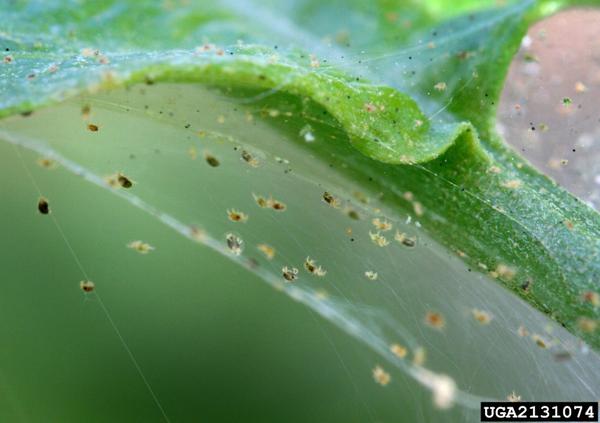Biology
Spider mites are an infrequent pest in grapes in North Carolina. A common species present in North Carolina is the two-spotted spider mite (Tetranychus urticae). Two-spotted spider mites are distinguished by the two dark splotches on either side of their abdomens. Over 200 species of plants are hosts to two-spotted spider mites, and they are pests of numerous horticultural and ornamental plants.
Two-spotted spider mites overwinter on weeds in the vineyard. In the spring, spider mites lay eggs on the leaves of their host plants. Mites go through a series of immature stages, called nymphs, before becoming adults capable of reproducing. Newly hatched spider mites have six legs, while larger nymphs and adults have eight legs. Spider mites have numerous generations per year, and generation time depends on temperature. During the warmest part of the summer, mites can go from egg to adult in less than a week, allowing populations to build rapidly. Mites grow best during periods of warm, dry weather.
Damage in North Carolina Grapes
Mites feed by sucking out the contents of individual plant cells. This feeding causes a speckled yellowing or bronzing of grape leaves. At low levels of feeding, grape plants can tolerate this damage with little yield loss. However, large mite outbreaks can cause browning of the leaves and reduce yields. In North Carolina, natural enemies of spider mites, usually keep populations in check below damaging levels, but occasionally outbreaks occur during periods of hot, dry weather or after applications of broad spectrum pesticides that kill off natural predators.
Sampling and Thresholds
Adult mites are about the size of a fleck of pepper (1/50th of an inch) and can be most easily observed with a hand lens. As mites are difficult to see directly, growers should check leaves for signs of damage and webbing. No economic thresholds exist for spider mites in North Carolina.
Management Options
Cultural Control
Variety selection can impact susceptibility to mite damage. Muscadines are highly tolerant of spider mites. Spider mites living on weeds can move onto grape vines after herbicide burn down. Maintaining suitable cover crops between rows can reduce problems with spider mites on grapes. Reducing dust in the vineyard can also reduce problems with two-spotted spider mites.
Conventional Insecticides
Organophosphate and pyrethroid insecticides used to control other pests are a common cause of flares of spider mites. Avoiding use of these materials can reduce the risk from mites. A number of miticides are labeled for controlling mites in grapes.
Refer to the North Carolina Agricultural Chemicals Manual for the most current recommendations on materials for control of two-spotted spider mites. Pesticide toxicity information for honeybees is also available in the North Carolina Agricultural Chemicals Manual.
Organic Insecticides
A few organically acceptable insecticides exist for two spotted spider mites, most of which are horticultural oils or soaps. As these materials make the leaves more sensitive to chemical burn injuries, oil or soap based miticides should not be used in conjunction with, or immediately before or after, fungicide sprays or foliar fertilizer sprays. Multiple applications may be necessary to control spider mites.
Refer to the North Carolina Agricultural Chemicals Manual for the most current recommendations on materials for grape root borer. Pesticide toxicity information for honeybees is also available in the North Carolina Agricultural Chemicals Manual.
Biological Control
Several species of predatory mites exist in North Carolina that feed on spider mites. Unlike spider mites, predatory mites have pear-shaped bodies and move quickly across the leaves. Purchase and release of predatory mites is usually not necessary, although it has not been well studied in North Carolina grapes. In general, predatory mites are only effective if released before spider mite populations get too large. Using miticides or broad spectrum pesticides after predatory mites are released will often kill these beneficial mites along with pest insects.
More Information
The Southern Region Small Fruit Consortium Bunch Grape IPM Guide contains regional recommendations for grape spider mite management.
Publication date: June 19, 2020
N.C. Cooperative Extension prohibits discrimination and harassment regardless of age, color, disability, family and marital status, gender identity, national origin, political beliefs, race, religion, sex (including pregnancy), sexual orientation and veteran status.



